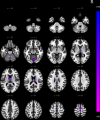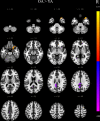Age-related and individual variations in altered prefrontal and cerebellar connectivity associated with the tendency of developing internet addiction
- PMID: 34170056
- PMCID: PMC8410527
- DOI: 10.1002/hbm.25562
Age-related and individual variations in altered prefrontal and cerebellar connectivity associated with the tendency of developing internet addiction
Abstract
Internet addiction refers to problematic patterns of internet use that continually alter the neural organization and brain networks that control impulsive behaviors and inhibitory functions. Individuals with elevated tendencies to develop internet addiction represent the transition between healthy and clinical conditions and may progress to behavioral addictive disorders. In this network neuroscience study, we used resting-state functional magnetic resonance imaging (rs-fMRI) to examine how and whether individual variations in the tendency of developing internet addiction rewire functional connectivity and diminish the amplitude of spontaneous low-frequency fluctuations in healthy brains. The influence of neurocognitive aging (aged over 60 years) on executive-cerebellar networks responsible for internet addictive behavior was also investigated. Our results revealed that individuals with an elevated tendency of developing internet addiction had disrupted executive-cerebellar networks but increased occipital-putamen connectivity, probably resulting from addiction-sensitive cognitive control processes and bottom-up sensory plasticity. Neurocognitive aging alleviated the effects of reduced mechanisms of prefrontal and cerebellar connectivity, suggesting age-related modulation of addiction-associated brain networks in response to compulsive internet use. Our findings highlight age-related and individual differences in altered functional connectivity and the brain networks of individuals at a high risk of developing internet addictive disorders. These results offer novel network-based preclinical markers of internet addictive behaviors for individuals of different ages.
Keywords: ALFF; aging; functional connectivity; internet addiction tendency.
© 2021 The Authors. Human Brain Mapping published by Wiley Periodicals LLC.
Conflict of interest statement
The authors report no conflicts of interest.
Figures




Similar articles
-
Individualized prediction of online shopping addiction from whole-brain functional connectivity.Neuropsychologia. 2024 Sep 9;202:108967. doi: 10.1016/j.neuropsychologia.2024.108967. Epub 2024 Aug 3. Neuropsychologia. 2024. PMID: 39103090
-
Aberrant posterior superior temporal sulcus functional connectivity and executive dysfunction in adolescents with internet gaming disorder.J Behav Addict. 2020 Sep 11;9(3):589-597. doi: 10.1556/2006.2020.00060. Print 2020 Oct 12. J Behav Addict. 2020. PMID: 32918802 Free PMC article.
-
Resting-state connectome-based support-vector-machine predictive modeling of internet gaming disorder.Addict Biol. 2021 Jul;26(4):e12969. doi: 10.1111/adb.12969. Epub 2020 Oct 12. Addict Biol. 2021. PMID: 33047425
-
Large-scale network dysfunction in youths with Internet gaming disorder: a meta-analysis of resting-state functional connectivity studies.Prog Neuropsychopharmacol Biol Psychiatry. 2021 Jul 13;109:110242. doi: 10.1016/j.pnpbp.2021.110242. Epub 2021 Jan 9. Prog Neuropsychopharmacol Biol Psychiatry. 2021. PMID: 33434637 Review.
-
Neural correlates of problematic gaming in adolescents: A systematic review of structural and functional magnetic resonance imaging studies.Addict Biol. 2022 Jan;27(1):e13093. doi: 10.1111/adb.13093. Epub 2021 Sep 8. Addict Biol. 2022. PMID: 34496459
Cited by
-
Psychosocial Basis of Human Sufferings and Poverty in Patients with Neurological and Psychiatric Disorders.Med Res Arch. 2023 May;11(5):3919. doi: 10.18103/mra.v11i5.3919. Epub 2023 May 20. Med Res Arch. 2023. PMID: 37641666 Free PMC article.
-
Physical exercise/sports ameliorate the internet addiction from college students during the pandemic of COVID-19 in China.Front Public Health. 2023 Dec 21;11:1310213. doi: 10.3389/fpubh.2023.1310213. eCollection 2023. Front Public Health. 2023. PMID: 38179571 Free PMC article.
-
Connectome-based predictive modeling of Internet addiction symptomatology.Soc Cogn Affect Neurosci. 2024 Feb 16;19(1):nsae007. doi: 10.1093/scan/nsae007. Soc Cogn Affect Neurosci. 2024. PMID: 38334691 Free PMC article.
-
Risks and protection: a qualitative study on the factors for internet addiction among elderly residents in Southwest China communities.BMC Public Health. 2024 Feb 20;24(1):531. doi: 10.1186/s12889-024-17980-6. BMC Public Health. 2024. PMID: 38378524 Free PMC article.
-
The Effect of Overcoming the Digital Divide on Middle Frontal Gyrus Atrophy in Aging Adults: Large-Scale Retrospective Magnetic Resonance Imaging Cohort Study.J Med Internet Res. 2025 Jul 22;27:e73360. doi: 10.2196/73360. J Med Internet Res. 2025. PMID: 40694409 Free PMC article.
References
-
- American Psychiatric Association . (2013). Diagnostic and Statistical Manual of Mental Disorders. Fifth Edition (DSM‐5). 10.1176/appi.books.9780890425596 - DOI
Publication types
MeSH terms
LinkOut - more resources
Full Text Sources

